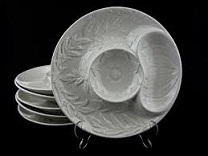The story of Antique Portuguese pottery, particularly faience, parallels the story of the Portuguese nation and its interaction with the nations of the world. Read on for more facts & information…
Strictly speaking faience is tin-glazed earthenware. Antique Portuguese pottery contains some interesting examples of this type of earthenware. The beginnings of Portuguese faience are shrouded in historical obscurity, however. Before the 17th century the provenance of any such pieces is pretty much in doubt.
Written records indicate possible production in Lisbon by the 13th century but absolutely no examples are extant. In fact not until the 16th century is evidence of such manufacture anything but sparse. After that time there appears to have been a great flowering of faience production in the city of Lisbon itself. Records exist for at least 10 pottery making facilities in that city by 1552.
Some have theorized that migrant artisans from Italy, the Low Countries and France had set up shop in Lisbon and started to make the antique Portuguese pottery we so much admire to this day. This sort of development is paralleled by an influx of tile painters from the very same regions around the same time and a corresponding influence on that activity.
Ironically enough, much of the ware made then ended up decorated in the manner of Chinese export porcelain made during the late Ming Dynasty. Products manufactured in the Italian-Style albarelli eventually arose in Lisbon as well.
Portuguese ceramics began to be designed with Chinese motifs by the mid-17th century exhibiting the classic cobalt blue drawn figures. Interest in these works was undoubtedly spurred by their popularity with Portuguese rich noble houses who invested in various items with these designs.
It may be true that certain of these mainly blue-and-white wares are somewhat fine renditions of Chinese porcelain, many more exhibit a nouveau riche, market-place appeal, with robustly drawn if somewhat garbled motifs in what has come to be known as the “Sinn-Portuguese” style. The Orient was fashionable throughout the whole of Western Europe at this time, although Portuguese trade with China was exceptionally intense compared to other European nations.
In any case, these designs evolved into something that approached the iconic as they became increasingly simplified and formalized: Chinese-border sunflowers morphed into spiky demi-lines or radiating scale patterns. The artemisia leaf began to resemble a spider.
Compartmentalized borders derived from kraal: porcelain persisted. Yet the vertiginous geometric patterns of the late Ming Dynasty style were supplanted by a simple “cross-stitch” trellis pattern.
By the 18th century Portuguese faience fell under the influence of the French potteries, especially those in Rouen. What distinguished the Portuguese wares was actually a lack of the meticulous attention to detail evident in the drawings found on the French product.
Portuguese faience is considerably more similar in feeling to the somewhat earthier or folk-oriented provincial French faience.





